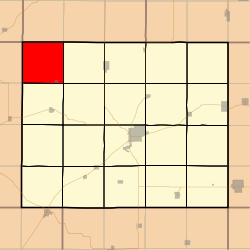케플러-28
Kepler-28| 관측 데이터 에폭 J2000 이쿼녹스 J2000 | |
|---|---|
| 별자리 | 백조자리[1] |
| 우측 상승 | 19h 28m 32.8905s[2] |
| 탈위임 | +42° 25′ 45.959″[2] |
| 겉보기 크기 (V) | 15.306[3] |
| 특성. | |
| 스펙트럼형 | M0V[4] |
| 아스트로메트리 | |
| 고유 운동 (μ) | RA:−0.488±0.042[2]mas/yr Dec.:11.692±0.042[2]mas/yr |
| 시차 (π) | 2.2527 ± 0.0241[2] 마스 |
| 거리 | 1,450 ± 20 리 (444 ± 5 pc) |
| 세부 사항 | |
| 미사 | 0.75[3] M☉ |
| 반지름 | 0.70[3] R☉ |
| 루미도 | [3] L☉ |
| 온도 | 4590[3] K |
| 금속성 [Fe/H] | 0.34[3] 덱스를 만들다 |
| 회전 | 17.951±0.016일[5] |
| 회전 속도 (v sin i) | 0.6km[3]/s |
| 기타 지정 | |
| 데이터베이스 참조 | |
| 심바드 | 자료 |
| KIC | 자료 |
케플러-28은 시그너스 북쪽 별자리에 있는 별이다.그것은 두 개의 외부 행성에 의해 궤도를 돈다.그것은 천체 좌표에 위치한다.우측 상승 19h 28m 32.8905, 탈하 +42s° 25° 45.959㎝.[2]겉으로 보이는 시각적 크기가 15.036인 이 별은 너무 희미해서 육안으로 볼 수 없다.[3]
행성계
케플러-28의 두 개의 따뜻한 넵튠 이남의[6] 가스 거대 행성들은 2011년에 발견되었고 2012년 초에 확인되었다.[7]
| 동반자 (별에서 순서대로) | 미사 | 세미마조르 축 (AU) | 궤도 주기 (일) | 편심성 | 기울기 | 반지름 |
|---|---|---|---|---|---|---|
| b | 8.8+3.8 −3.1 M🜨 | 0.062 | 5.9123 | — | — | 2.93±0.46 R🜨 |
| c | 10🜨.9M+6.1 −4.5 | 0.081 | 8.9858 | — | — | 2.77±0.44 R🜨 |
참조
- ^ "Cygnus – constellation boundary", The Constellations, International Astronomical Union, retrieved 2011-12-15
- ^ a b c d e f Brown, A. G. A.; et al. (Gaia collaboration) (August 2018). "Gaia Data Release 2: Summary of the contents and survey properties". Astronomy & Astrophysics. 616. A1. arXiv:1804.09365. Bibcode:2018A&A...616A...1G. doi:10.1051/0004-6361/201833051. 이 소스에 대한 가이아 DR2 기록 VizieR.
- ^ a b c d e f g h Kepler-28b, NASA Ames Research Center, archived from the original on 2012-05-03, retrieved 2011-12-06
- ^ "Kepler-28". SIMBAD. Centre de données astronomiques de Strasbourg. Retrieved 10 January 2017.
- ^ McQuillan, A.; Mazeh, T.; Aigrain, S. (2013). "Stellar Rotation Periods of The Kepler objects of Interest: A Dearth of Close-In Planets Around Fast Rotators". The Astrophysical Journal Letters. 775 (1). L11. arXiv:1308.1845. Bibcode:2013ApJ...775L..11M. doi:10.1088/2041-8205/775/1/L11.
- ^ a b Cubillos, Patricio; Erkaev, Nikolai V.; Juvan, Ines; Fossati, Luca; Johnstone, Colin P.; Lammer, Helmut; Lendl, Monika; Odert, Petra; Kislyakova, Kristina G. (2016), "An overabundance of low-density Neptune-like planets", Monthly Notices of the Royal Astronomical Society, 466 (2): 1868–1879, arXiv:1611.09236, doi:10.1093/mnras/stw3103, S2CID 119408956
- ^ Steffen, Jason H.; Fabrycky, Daniel C.; Ford, Eric B.; Carter, Joshua A.; Desert, Jean-Michel; Fressin, Francois; Holman, Matthew J.; Lissauer, Jack J.; Moorhead, Althea V.; Rowe, Jason F.; Ragozzine, Darin; Welsh, William F.; Batalha, Natalie M.; Borucki, William J.; Buchhave, Lars A.; Bryson, Steve; Caldwell, Douglas A.; Charbonneau, David; Ciardi, David R.; Cochran, William D.; Endl, Michael; Everett, Mark E.; Gautier III, Thomas N.; Gilliland, Ron L.; Girouard, Forrest R.; Jenkins, Jon M.; Horch, Elliott; Howell, Steve B.; Isaacson, Howard; et al. (2012), Transit Timing Observations from Kepler: III. Confirmation of 4 Multiple Planet Systems by a Fourier-Domain Study of Anti-correlated Transit Timing Variations, arXiv:1201.5412, doi:10.1111/j.1365-2966.2012.20467.x, S2CID 11898578
- ^ Schneider, Jean, "Star: Kepler-28", Extrasolar Planets Encyclopaedia, Paris Observatory, archived from the original on 2012-04-26, retrieved 2011-12-06


